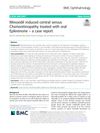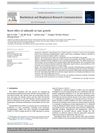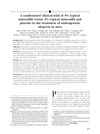TLDR Minoxidil can cause temporary vision loss and color blindness.
A man in his early 20s experienced a throbbing headache and blurred vision after using oral and topical minoxidil for alopecia. Examination revealed hyperaemic optic discs and achromatopsia, with the patient unable to read the Ishihara colour vision chart. Suspecting an adverse reaction to minoxidil, the medication was discontinued, leading to an improvement in vision and resolution of achromatopsia without further intervention. This case highlights the potential for minoxidil to cause transient vision loss and achromatopsia, emphasizing the need for caution and monitoring when using this medication.
 March 2024 in “Case Reports in Ophthalmology”
March 2024 in “Case Reports in Ophthalmology” A young woman developed a vision-threatening eye condition after using minoxidil for hair loss, which improved when she stopped the medication.
 4 citations
,
June 2020 in “BMC Ophthalmology”
4 citations
,
June 2020 in “BMC Ophthalmology” Minoxidil can cause a rare eye condition, but it was successfully treated with oral Eplerenone in one case.
 16 citations
,
October 2018 in “Biochemical and Biophysical Research Communications”
16 citations
,
October 2018 in “Biochemical and Biophysical Research Communications” Sildenafil, often used for erectile dysfunction, may help hair growth.
 August 2023 in “Journal of Cosmetic Dermatology”
August 2023 in “Journal of Cosmetic Dermatology” Some plants like spinach, broccoli, and matcha may boost the effectiveness of the hair growth drug minoxidil.
5 citations
,
January 2018 in “Italian journal of dermatology and venereology” Minoxidil effectively stimulates hair growth in androgenetic alopecia.
 269 citations
,
August 2002 in “Journal of The American Academy of Dermatology”
269 citations
,
August 2002 in “Journal of The American Academy of Dermatology” 5% minoxidil works better for hair growth and density, with minor irritation.





